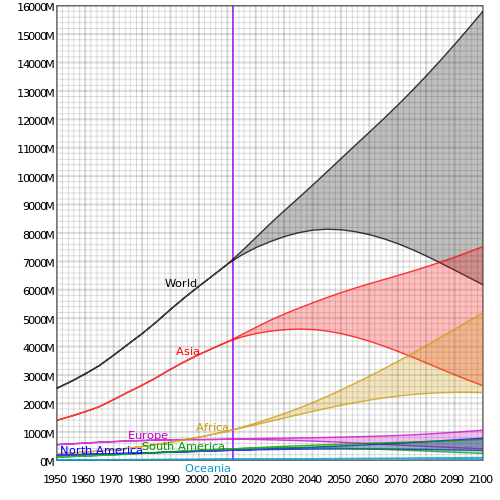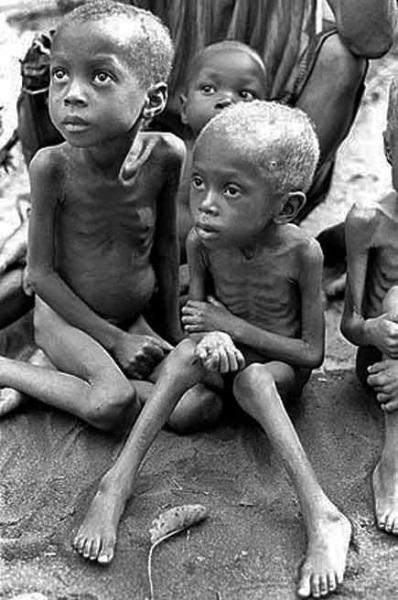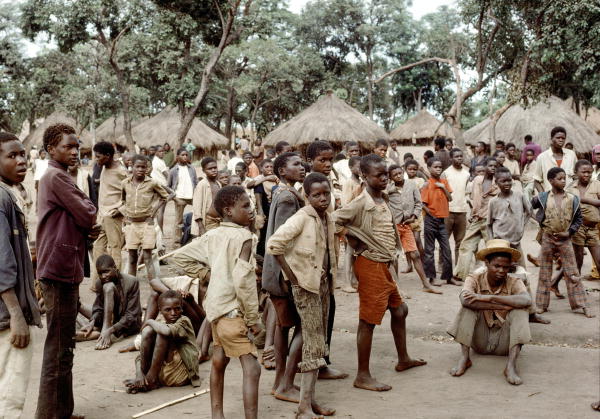Future Population Increase and its Impact on Food Supply
Earth is becoming increasingly crowded. Global population stands at just over 8 billion and is rising by 78 million people per year. Now, if that number does not sound like a lot to you, think about it this way--we are adding close to the population of Germany every year to our crowded planet! Currently, 134 million children are born every year, that is 367 thousand per day, and there are approximately 56 million deaths per year. At this rate, the population is predicted to reach 9 billion by about 2046. It's mind-boggling to think that global population when many of you were born stood at just over 5 billion! The graph below shows the massive increase in global population as well as these scary projections. It demonstrates how global population increase has been driven by surging populations of Africa and, especially, Asia.

The video below portrays the recent growth in population as well as the outlook.
Video: 7 Billion, National Geographic Magazine (2:57) This video is set to music and not narrated.
[MUSIC]
TEXT ON SCREEN: 7 billion is a big number. By the end of 2011, YOU will be one of 7 billion people living on earth. It would take 200 years just to count to 7 billion out loud. 7 billion steps would take you around the globe 133 times. In 1800, the world’s population was 1 billion.
130 years later, 1930 = 2 billion. 1960 = 3 billion. 1974 = 4 billion. 1987 = 5 billion. 1999 = 6 billion. 2011 = 7 billion. In 2045, it could be 9 billion.
About every second 5 people are born, 2 people die. In the time you’ve watched this video, our population has increased by 170 people. And nearly everywhere, we’re living longer. In 2010, the average person lived 69 years. In 1960 the average person lived 53 years.
In 2008, for the first time ever, more of us lived in cities than rural areas. Megacity = population greater than 10 million. In 1975 there were 3 megacities: Mexico. Tokyo, and New York City. Right now there are 21 megacities. By 2050, 70% of us will be living in urban areas but… we don’t take up as much space as you’d think. Standing shoulder to shoulder, all 7 billion of us would fill the city of Los Angeles.
So it’s not space we need. It’s balance. 5% of us consume 23% of the world’s energy. 13% of us don’t have clean drinking water. 38% of us lack adequate sanitation.
7 billion people, speaking more than 7,000 languages, living in 1994 countries. 7 billion reasons to think about.
In 1798, Thomas Malthus wrote An Essay on the Principle of Population. In this work, he predicted that populations of nations would be restricted by the availability of food because nations would not be able to control birth rate. The essay has been intensely debated by evolutionary biologists, economists, and many others for the last two centuries. Repeated famines around the globe generally support Malthus' hypothesis.
Regardless, we find ourselves in a position today where the world is currently not able to feed all of its inhabitants. Currently, more than one billion people are estimated to lack sufficient food, and more than twice that number do not receive adequate nutrition. This situation will likely become a lot more dire in the future. In fact, predictions for population increase diverge significantly in the later parts of the century because some models assume mass mortality due to widespread famine. To make matters worse, climate change is predicted to cause major problems to crop yields, especially in parts of the world where the population is growing the fastest. These shortages will likely lead to mass migration of huge numbers of people, possibly entire nations.
Agriculture is an essential part of every society. Forty percent of the Earth’s surface is managed for cropland and pasture. That is more than for any other activity including forestry, which comprises 30% of Earth's area. In underdeveloped countries, approximately 70% of the population live in rural areas where agriculture is the major activity. There are many diverse sources of food, and populations around the world have very different diets and demands. In addition to crop and livestock, fish is a stable diet in many countries. Projections for climate change differ significantly for these various food sources, thus we will discuss them separately. For crop farming, in particular, the impact of climate change is very different for agro-businesses run by multinational corporations in the developed nations than for family-operated farms in the developing world.
Family Farming
Climate change will have very different impacts on different continents, and socio-economic factors will govern the abilities of nations to respond. Even though the south-central and southwestern US are likely to face extreme drought in the coming decades, inhabitants and businesses should by and large be able to adapt. It will be a starkly different situation in Southern Africa, India and Southeast Asia, Mexico, northeast Brazil, southern Africa, and West Africa, where climate change will be coupled with a general lack of coping mechanisms. In all of these regions, the impact of climate change, and the inability of societies to fully cope with it will potentially result in security issues including soaring food prices and military conflicts.
Food shortages will not be a new problem in many places. Mass migrations driven by food supply have been an important part of human evolution and a tragic part of the history of many nations, especially those in Africa. As we saw in Module 2, famine caused by drought is thought to have caused the collapse of the Mayan civilization in Central America around 850 AD. More recently in China, famine in the late part of the 19th century caused the death of some 60 million people. Famine is possible even in the developed world. The Irish potato famine between 1845 and 1852 caused by a potato disease called potato blight led to approximately 1 million deaths, between 20 and 25% of the population of that country. This problem does not appear to be improving with time. In the 20th century, 70 million people are thought to have died during famines: 30 million alone in China between 1958 and 1961, and 7-10 million in India in 1943.
Nowhere is the history of famine more devastating than in Africa. Famines on the African continent, like elsewhere, have often resulted from a combination of drought and political conflicts, oppressive military regimes, and war. Most recently, the conflict in the Darfur region of Sudan erupted over water in 2003. One side of the conflict, consisting of migratory farmers, has displaced large numbers of sedentary farmers to parts of the country without sufficient food and water. Mass mortality has largely been caused by disease. Estimates of the number of dead are uncertain, but are between 180,000 and 460,000. This number is much less than the number of mortalities in the Biafran conflict of Nigeria between 1967 and 1970 when nearly a million people died from conflict and starvation. Today, more than a third of Africans suffer from hunger.

The following video portrays the tragic history of famines.
Video: Famines throughout the ages: 19th-21st Century Pt. 2 of 2 (10:14) Set to music.This video is not narrated.
Famines throughout the Ages: 19th Century to Present Day. Is your country at risk?
19th century
1800-1801 famine in Ireland. Four famines - in 1810, 1811, 1846, and 1849 - in China claimed nearly 45 million lives. 1811-1812 famine devastated Madrid, taking nearly 20,000 lives. 1815 eruption of Tambora, Indonesia. Tens of thousands died of subsequent famine. 1816-1817 famine in Europe (Year Without a Summer). 1830 famine killed almost half the population of the Cape Verde Islands. 1830’s Tenpo famine. 1835 famine in Egypt killed 200,000. 1844-1846 famine in Belgium. 1845-1857 Highland Potato Famine in Scotland in result 2 million Scots emigrated. 1845-1849 Great Irish Famine killed more than 1 million people.1846 famine led to the peasant revolt known as “Maria da Fonte” in the north of Portugal. 1850-1873 as a result of Taiping Rebellion, drought, and famine, the population of China drop by over 60 million people. 1866 Orissa famine in India; one million perished. 1866-1868 Famine in Finland. About 15% of the entire population died. 1869 Rajputana famine in India; one million and a half perish. 1879 Famine in Ireland. 1870-1871 famine in Persia is believed to have caused the death of 2 million persons. 1873-1874 famine in Anatolia. All mortality avoided in Bihar famine of 1873 -74 in India (This is a success story). 1876-1879 ENSO Famine in India, China, Brazil, Northern Africa (and other countries). Famine in northern China killed 13 million people. 5.25 million die in the Great Famine of 1876-78 in India. 1878-1880 famine in St. Lawrence Island, Alaska. 1888 famine in Sudan. 1888-1892 Ethiopian Great famine. About one-third of the population died. Conditions worsen with cholera outbreaks (1889-92), a typos epidemic, and a major smallpox epidemic (1889-90). 1891-1892 famine in Russia caused 375,000 to 500,000 deaths. 1896-1897 ENSO Famine in northern China leading in part to the Boxer Rebellion. 1896-1902 ENSO Famine in India.
20th Century
1906, 1911 famines in Russia. 1907, 1911 famines in east-central China. 1914-1918 Mount Lebanon famine during World War I which killed about a third of the population. 1914-1918 famine in Belgium.
Food as a weapon. Ukraine was the wheat growing bread basket of Europe. But in 1932, when the mostly Christian Ukranians planned independence from the brutal communist regime of the Soviet Union, the ruling Jewish Bolsheviks, headed by dictator Josef Stalin, sent in the Red Army to confiscate and lock away their grain. Ukraine borders were then sealed. No food could get in, and no one could escape. Unspeakable horror followed. In the two years of this man-made famine, 10 million people and their animals starved to death in inhuman suffering. Stalin made films convincing the outside world all was fine in the Ukraine. The 20-30 million starved and shot, ended the revolution. Only now is this Zionist-inspired genocide talked about. Food as a weapon. It still happens.
1915-1916 Armenian Genocide. Armenian deportees starved to death. 1916-1917 famine caused by the British blockade of Germany in WWI. 1916-1917 winter famine in Russia. 1917-1919 famine in Persia. As much as 1/4 of the population living in the north of Iran died in the famine. 1917-1921 a series of famines in Turkestan at the time of the Bolshevik revolution killed about a sixth of the population. 1921 famine in Russia killed 5 million. 1921-1922 famine in Tatarstan. Some people in Russia were so hungry they ate their own children. 1921-1922 famine in Volga German colonies in Russia. One-third of the entire population perished. 192801929 famine in northern China. The drought resulted in 3 million deaths. 1928-1929 famine in Ruanda-Burundi, causing large migrations to the Congo. 1932-1933 Soviet famine in Ukraine (Holdomor), some parts of Russia and North Caucaus area. 2.6 to 10 million people may have died. Six million perish in Soviet famine. Peasant’s crops seized, they and their animals starve. 1932-1933 famine in Kazakhstan killed 1.2-1.5 million. 1936 famine in China, with an estimated 5 million fatalities. 1940-1943 famine in Warsaw Ghetto. 1941-44 Leningrad famine caused by a 900-day blockade by German troops. About one million Leningrad residents starved, froze, or were bombed to death in the winter of 1941-42, when supply routes to the city were cut off & temperatures dropped. 1941-44 famine in Greece caused by the Axis occupation. An estimated 300,000 people perished. 1942-1943 famine killed one million in China. 1943 famine in Bengal. 1943 famine in Ruanda-Urundi, causing migrations to the Congo. 1944 famine in the Netherlands during World War II, more than 20,000 deaths. 1945 famine in Vietnam. 1946-47 famine in Soviet Union killed 1-1/5 million. 1958 famine in Tigray, Ethiopia, claimed 100,000 lives. 1959-1961 Great Leap Forward/The Great Chinese Famine (China). The official statistic is 20 million deaths, as given by Hu Yaobang. 1965-1967 drought in India responsible for 1.5 million deaths. 1967-1970 Biafran Faine caused by Nigerian blockade. Life: Starving Children of Biara war. 1968-1972 Sahel drought created a famine that killed a million people. 1973 famine in Ethiopia; failure of the government to handle this crisis led to fall of Haile Selassie and to Derg rule. 1974 famine in Bangladesh. 1975-1979 Khmer Rouge. An estimated 2 million Cambodians lost their lives to murder, forced labor, and famine. 1980 famine in Karamoja, Uganda. 1984 famine in Ethiopia. 1991-1993 Somalian famine. 1996 North Korean famine. Scholars estimate 600,000 died of starvation (other estimates range from 200,000 to 3.5 million). 1993 famine in Sudan caused by water and drought.
Pulitzer 1994 Kevin Carter
The PHOTO in the mud is the “Pulitzer Prize” winning photo taken in 1994, during the Sudan famine. The picture depicts a famine-stricken child crawling towards an United Nations food camp, located a kilometer away. The vulture is waiting for the child to die so that it can eat it. This picture shocked the whole world. No one knows what happened to the child, including the photographer Kevin Carter who left the place as soon as the photograph was taken. Three months later he committed suicide due to depression.
1998 ENSO Famine in Northeaster Brazil. 1998-2000 famine in Ethiopia. The situation worsened by Eritrean-Ethiopian War. 1998-2004 Second Congo War. 3.8 million people died, mostly from starvation and disease. 2000-2009 Zimbabwe’s food crisis caused by Mugabe’s land reform policies.
21st Century
2003 famine in Sudan/Darfur (Darfur conflict). 2005 Malawi food crisis. 2005-06 Niger food crisis. 2006 Horn of Africa food crisis. 2008-Myanmar food crisis. The Cyclone Nargis devastated Burma’s major rice-producing region. 2008-North Korean famine. 2008-Horn of Africa food crisis. 2008 Afghanistan food crisis. 2008-Bangladesh food crisis. 2008 East Africa food crisis. 2008 Tajikistan food crisis. 2009 Kenya food crisis. 10 million Kenyans face starvation. How much confidence do you have in your flood suppliers? Most of the people in this country have no idea what it takes to put food on their table. What does it take? What’s wrong with the bees? If you want to grow fruits vegetables or nuts on a commercial basis in the United States, you need to have soil. Sun seeds water and honeybees. Millions and millions of honeybees trucked in from all over the country to pollinate the crops. On average, Hackenberg and his bees log 60,000 miles a year on the road wintering in Florida to work citrus and cantaloupe. Then back north in the spring for apples and cherries, maybe even to California for the almond crop. He's just a small part of an industry that pollinates 90 different crops worth an estimated 15 billion dollars. And most people don't even know it exists.
CCD/Colony Collapse Disorder
One documentary writer who was here and looked at these two months after I was here, described this not as bee hives, but as a graveyard with these empty white boxes with no bees left in them. Now I'm going to sum up a year's worth of work in two sentences. To say that, we have been trying to figure out what the cause of this is and what we know is that it's as if the bees have caught a flu and this flu has wiped through the population of bees. And the question that keeps us up at night is, why have the bees suddenly become so susceptible to this flu? And why are they so susceptible to these other diseases? And we don't have the answer to that yet. And we spend a lot of time trying to figure that out. If we had taken out all those ingredients the bees had indirectly or directly pollinated, we wouldn't have much on our plate. Could you grow these pumpkins without bees? It wouldn't be profitable. What happens if you have another big die-off? I'm probably out of this. If there's another big die-off of bees, some beekeepers, maybe many beekeepers, are going to go out of business. And what does that do to vegetables and fruits in the supermarket? We won't have the quality fruits. We may not have the quantity of fruits and vegetables. And this could mean higher prices at the grocery store, and it'll hit the public directly. Why is that? What does the Bible say will happen in the last days? Do you depend on commercial farming? What will happen if they go out of business? Are you growing your own foods? Or storing it? If not, you’re at risk!


